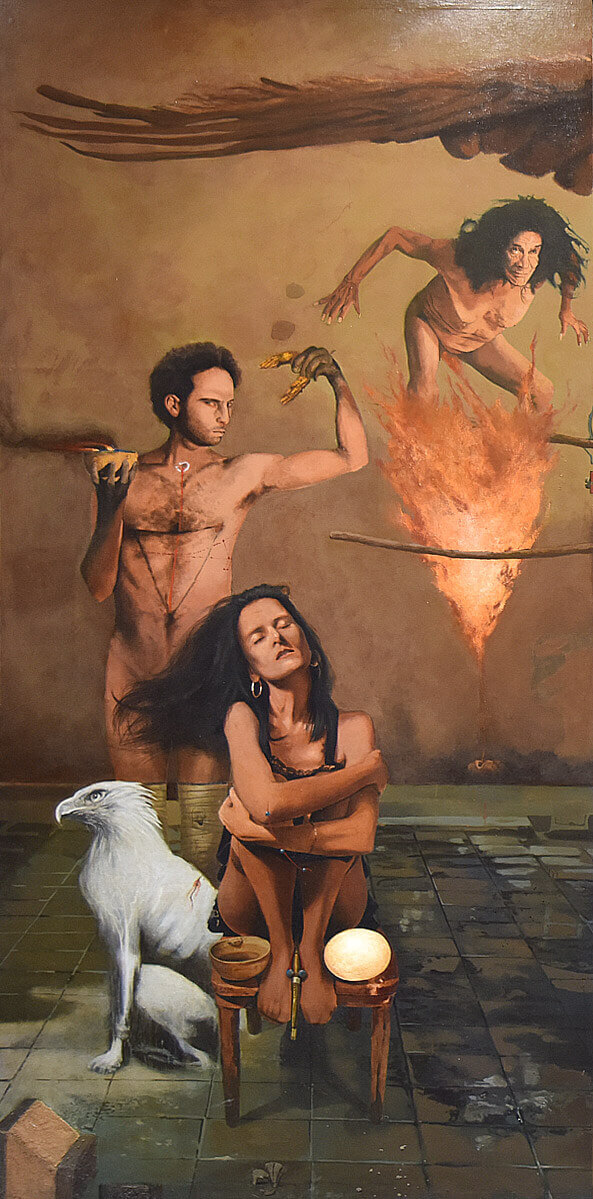Loading...
Arturo Rivera
Mexico City, April 15, 1945 – October 29, 2020
As in other fields of culture, 1968 marked a milestone in the evolution of modern Mexican art, and then the 1970s gave rise to the emergence of "groups" that proclaimed a message art expressed through interdisciplinary manifestations of conceptualist essence, such as the happening and the performance. It was in those uncertain years that Arturo Rivera, born in Mexico City on April 15, 1945, into a well-off family, began his artistic career.
Rivera had barely finished school in 1968. It was a time of total confusion. He himself mentions that he was part of that generation that came after the Rupture. At that time, the painter tells us, everyone wanted to paint following the New York school. He was labeled as old because he always had a great inclination towards drawing. He did the first two years at the San Carlos Academy with the corresponding curriculum: in third year he followed masters such as Antonio Rodríguez Luna and Francisco Moreno Capdevilla.
In the midst of this chaos, Rivera suffered a strong crisis and stopped painting for four years. Between 1973 and 1974 he studied serigraphy and photo-serigraphy in London and in 1976 he decided to move to New York, where he stayed for four years. He worked at some sort of painting factory where labor was hired to reproduce paintings that were sold in large quantities to decorate offices and hotels.
At that time he was very influenced by Francis Bacon in his way of conceiving spaces and atmospheres. An event occurred that marked a milestone in his career: he was commissioned to do a painting for the Casa de las Américas of Cuba. Rivera made a drawing on paper and for the first time he let his unconscious flow freely. The result was Portrait of an Illness (1979), the first work in which he fully recognized himself. Shortly after, he met Max Zimmermann, a surrealist artist who invited him to Germany to participate in his painting classes at the Kunstakademie in Munich. At that time he noticed a very marked tendency towards realism. He remained in Germany for two years until Fernando Gamboa invited him to prepare an exhibition in Mexico at the Museum of Modern Art in 1981. He returned with the idea of staying only a few months, but other projects arose and so his stay was prolonged.
By 1977 Rivera had already explored the fusion between the stain of informal roots and a figuration without detail, resolved with few strokes and that seemed to be fused with its abstract complement. Although his proposal lacked sufficient audacity, it was advanced. In 1978 he moved towards a mixture of new figuration, first verist and then somewhat expressionist.
In the 1980s he remained faithful to his exacerbated realism. At the beginning of the decade he worked on the series called "El rastro del dolor" (The trace of pain), which comprises fifty-four drawings, in which he mostly used the technique of graphite and tempera on paper. Between 1989 and 1990 he dedicated himself to the series known as "Historia del ojo" (The history of the eye), twenty-four drawings on paper, threaded together by the recurring presence of an eye that serves as a pretext and protagonist of fantastic stories. In 1994, he presented twenty-five paintings and drawings in egg tempera and oils based on biblical themes.
In the 1990s, Rivera showed his mature work at the Museum of Modern Art in Mexico City, which he produced from 1980 to 1995, under the title "Bodas del cielo y el infierno" (Weddings of Heaven and Hell). In 2000, the Fine Arts Museum presented three lustrums of artistic production of his enigmatic plastic universe in the exhibition "El rostro de los vivos" (The Face of the Living). Recipient of the many awards around the world, highlighting: first place at the II International Art Biennial in Beijing, China, in 2005.
Arturo Rivera's self-portraits are a profound testimony of his temperament and inner turbulence. In them, he leaves evidence of his "style" or signs with which he populates his works, surrounding himself with the iconography that defines his cryptic universe. By way of small illuminations or painful stabs, and with the risk of such an interpretation, we sense his inner self and it unsettles us, provokes us. Its iridescent and distressing veils can be a sign of knowledge, but also of the tragedy of knowing. We could think that by means of transparencies and glazes he manages to communicate an irony to the spectator: "What you see here is not me, it is the painting". A virtuoso of composition and the language of forms, he tells us that as an artist he is a being that bifurcates in creation.
Rivera died on October 29, 2020, in Mexico City.







All Rights Reserved , Banco Santander México S.A., Institución de Banca Múltiple, Grupo Financiero Santander México.